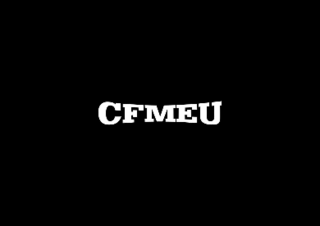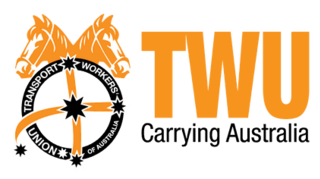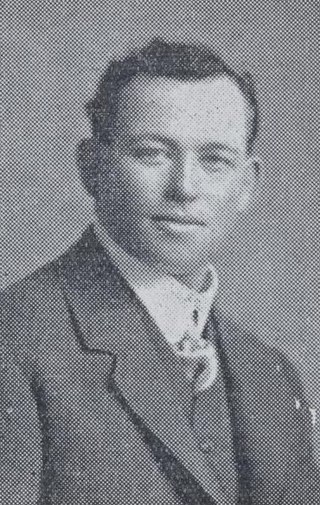The 1913 Australian referendum was held on 31 May 1913. It contained six referendum questions and was held in conjunction with the 1913 federal election.
The Australian Workers' Union (AWU) is one of Australia's largest and oldest trade unions. It traces its origins to unions founded in the pastoral and mining industries in the late 1880s and it currently has approximately 80,000 members. It has exercised an outsized influence on the Australian Trade Union movement and on the Australian Labor Party throughout its history.

The National Union of Workers was an Australian trade union that formed in 1989. The union covered workers in various industries and was one of the most powerful unions in the Australian Labor Party and its national Labor Right faction. In 2019, it merged with United Voice to form the United Workers Union.

The Construction, Forestry and Maritime Employees Union (CFMEU) is the largest union in construction, forestry, maritime, textile, clothing and footwear production. The CFMEU is affiliated with the Australian Council of Trade Unions and the Australian Labor Party.

United Voice was a large Australian trade union, with over 130,000 members. United Voice members worked in a wide range of occupations including hospitality, childcare, teachers' aides, aged care, property services, health, manufacturing, ambulance workers and community services.

The Transport Workers' Union of Australia (TWU) is a trade union with members throughout Australia. It has 5 main branches based in: Australian Capital Territory/New South Wales; Queensland; Victoria/Tasmania; South Australia/Northern Territory; and Western Australia.

The Australian Chamber of Commerce and Industry (ACCI) is Australia's largest and most representative business association, comprising state and territory chambers of commerce and national industry associations. ACCI represents Australian businesses of all shapes and sizes, across all sectors of the economy, and from every corner of the country.

The Federated Miscellaneous Workers' Union (F.M.W.U.), commonly known as the 'Missos', was an Australian trade union which existed between 1915 and 1992. It represented an extremely diverse and disparate range of occupations, but its core support came from workers employed in cleaning and security services.

The Builders Labourers Federation (BLF) was an Australian trade union that existed from 1911 until 1972, and from 1976 until 1986, when it was permanently deregistered in various Australian states by the federal Hawke Labor government and some state governments of the time. This occurred in the wake of a Royal Commission into corruption by the union. About the same time, BLF federal secretary Norm Gallagher was jailed for corrupt dealings after receiving bribes from building companies that he used to build a beach house.
Marine Cooks, Bakers and Butchers' Association of Australasia was an Australian trade union. It was formed in Melbourne in August 1907 as a breakaway group from the Federated Stewards and Cooks' Union of Australia and was registered under the Commonwealth Conciliation and Arbitration Act 1904 in January 1908 and affiliated with the Trades and Labour Council in April 1908. The Association represented workers employed as cooks, bakers, butchers and other food preparation roles aboard ships in Australia and New Zealand. In November 1908 Mr Justice Higgins issued a judgement on rates of pay and hours for marine cooks in a case involving the Association and the Commonwealth Steamship Owners' Association. The Association moved its Head Office moved from Melbourne to Sydney in January 1915.
Manufacturing Grocers' Employees' Federation of Australia (M.G.U.) was an Australian trade union existing between 1906 and 1988. The union was first established as the Federated Candle, Soap, Soda & Starch Employees' Union of Australia, before changing its name in 1914. The union represented workers employed in manufacturing grocers' sundries and non-edible grocery products, particularly in the southern states of South Australia and Victoria. In 1988 the union amalgamated with the Federated Millers and Mill Employees' Union to form the Federated Millers and Manufacturing Grocers Employees' Association of Australia, which in turn merged with a number of unions to form the National Union of Workers.
Federated Millers and Manufacturing Grocers Union was an Australian trade union. It represented workers in food processing and manufacturing industries.
Federated Liquor and Allied Industries Employees' Union of Australia (FLAIEU) was an Australian trade union which existed between 1910 and 1992. It represented workers employed in hospitality, catering, breweries and alcohol retailing.

The Federated Ironworkers' Association of Australia (FIA) was an Australian trade union which existed between 1911 and 1991. It represented labourers and semi-skilled workers employed in the steel industry and ironworking, and later also the chemical industry.

Francis Joseph "Frank" Condon was a trade unionist and Labor politician in South Australia.
The Federated Moulders' (Metals) Union of Australia (FMMUA) was an Australian trade union which existed between 1899 and 1983. It represented moulders – skilled tradesmen who fabricated the moulds for casting metal products in foundries. In spite of only organising within a single skilled occupation, which kept total membership low, the vital position of moulders in major industries such as mining, manufacturing and the railways, ensured that the union remained industrially powerful with a reputation for being highly militant.
The Australian Federated Union of Locomotive Employees (AFULE) is an Australian trade union representing railway workers. It was formerly a national union which largely merged into the Australian Rail Tram and Bus Industry Union in 1992; however, the Queensland division continued as a separate union active only in that state.
The Pulp and Paper Workers Federation of Australia (PPWF) was an Australian trade union which existed between 1913 and 1991. The PPWF represented workers in the pulp and paper industry.
The Australian Coal and Shale Employees' Federation was an Australian trade union representing workers in the coal mining industry from 1913 to 1990.









